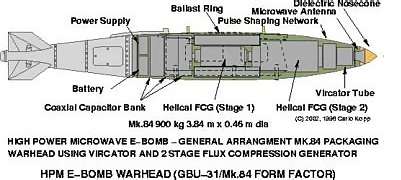

"The U.S. Air Force has hit Iraqi TV with an experimental electronmagetic pulse device called the 'E-Bomb' in an attempt to knock it off the air and shut down Saddam Hussein's propaganda machine. Iraqi satellite TV, which broadcasts 24 hours a day outside Iraq, went off the air around 4:30 a.m. local time."
- CBS News, 3-25-03
E-bombs can unleash in a flash as much electrical power—2 billion watts or more—as the Hoover Dam generates in 24 hours. [And], although the Pentagon prefers not to use experimental weapons on the battlefield, "the world intervenes from time to time," - Defense Secretary Donald Rumsfeld.
- Time Magazine, 1-19-03
The next Pearl Harbor will not announce itself with a searing flash of nuclear light or with the plaintive wails of those dying of Ebola or its genetically engineered twin. You will hear a sharp crack in the distance. By the time you mistakenly identify this sound as an innocent clap of thunder, the civilized world will have become unhinged. For, the "E-bomb" has come of age.
America has remained at the forefront of EMP weapons development. Although much of this work is classified, it's believed that current efforts are based on using high-temperature superconductors to create intense magnetic fields. [And it's] an astoundingly simple weapon. It consists of an explosives-packed tube placed inside a slightly larger copper coil. The instant before the chemical explosive is detonated, the coil is energized by a bank of capacitors, creating a magnetic field. The explosive charge detonates from the rear forward. As the tube flares outward it touches the edge of the coil, thereby creating a moving short circuit. "The propagating short has the effect of compressing the magnetic field while reducing the inductance of the stator [coil]," says Carlo Kopp, an Australian-based expert on high-tech warfare. "The result is that FCGs will produce a ramping current pulse, which breaks before the final disintegration of the device. Published results suggest ramp times of tens of hundreds of microseconds and peak currents of tens of millions of amps." The pulse that emerges makes a lightning bolt seem like a flashbulb by comparison.

There is, however, another part to the E-bomb story, one that military planners are reluctant to discuss. While American versions of these weapons are based on advanced technologies, terrorists could use a less expensive, low-tech approach to create the same destructive power. "Any nation with even a 1940s technology base could make them," says Kopp. "The threat of E-bomb proliferation is very real." POPULAR MECHANICS estimates a basic weapon could be built for just $400.
For general advice on EMP shielding for your electronic systems, CLICK HERE.
 BACK to the "Uses" page at Superconductors.ORG
BACK to the "Uses" page at Superconductors.ORG
 BACK to the "News" page at Superconductors.ORG
BACK to the "News" page at Superconductors.ORG